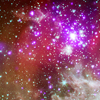CXC Home | Search | Help | Image Use Policy | Latest Images | Privacy | Accessibility | Glossary | Q&A
Tour of NGC 281
Quicktime MPEG
High-mass stars are important because they are responsible for much of the energy pumped into a galaxy over its lifetime. Unfortunately, these stars aren't understood very well because they are usually found relatively far away in places where lots of gas and dust can impede out line of sight. The star cluster NGC 281 is an exception to this rule. It is located about 6,500 light years from Earth and almost 1,000 light years above the plane of the Galaxy. This means it's away from much of stuff that blocks our view. Here we see NGC 281 in X-rays from Chandra and infrared data from Spitzer. The high-mass stars in NGC 281 have powerful winds flowing from their surfaces and intense radiation that heats surrounding gas, "boiling it away" into interstellar space. This process results in the formation of large columns of gas and dust, as seen on the left side of the image. These structures likely contain newly forming stars. The eventual deaths of massive stars as supernovas will also seed the galaxy with material and energy.
[Runtime: 01:29]
Quicktime MPEG
High-mass stars are important because they are responsible for much of the energy pumped into a galaxy over its lifetime. Unfortunately, these stars aren't understood very well because they are usually found relatively far away in places where lots of gas and dust can impede out line of sight. The star cluster NGC 281 is an exception to this rule. It is located about 6,500 light years from Earth and almost 1,000 light years above the plane of the Galaxy. This means it's away from much of stuff that blocks our view. Here we see NGC 281 in X-rays from Chandra and infrared data from Spitzer. The high-mass stars in NGC 281 have powerful winds flowing from their surfaces and intense radiation that heats surrounding gas, "boiling it away" into interstellar space. This process results in the formation of large columns of gas and dust, as seen on the left side of the image. These structures likely contain newly forming stars. The eventual deaths of massive stars as supernovas will also seed the galaxy with material and energy.
[Runtime: 01:29]
(Credit: NASA/CXC/A. Hobart)
Return to NGC 281 (September 28, 2011)



